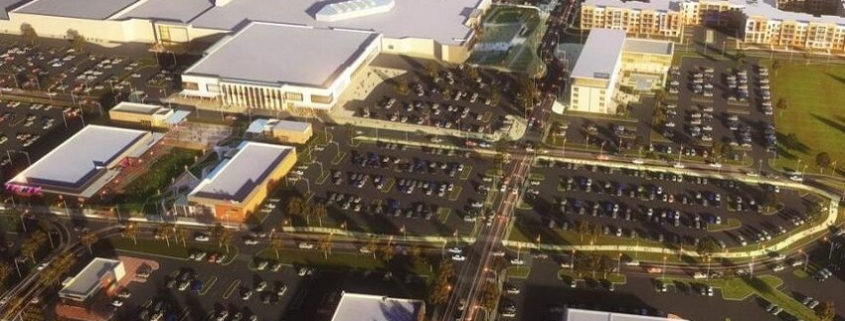Five years after launching the redevelopment of Redbird Mall in Southern Dallas, owner and developer Peter Brodsky has proven his thesis—the demand for a vibrant mixed-use development south of Interstate 30 in Dallas is a sustainable investment that generates a profit.

Rendering: Reimagine Redbird
Reimagine Redbird, the revitalization project of a historic 1975 mall in Southern Dallas, is now home to the only Starbucks in the 208 square miles of Southern Dallas and the location is the No. 3 top performing Starbucks in the city. The development has created 1,000 living wage call center jobs with Chime Solutions, Class A apartments at the Palladium Redbird, the DEC—a thriving incubator space for entrepreneurs, and more.
“I am excited that a short five years later, we’ve really got momentum here,” said Brodsky, at a Wednesday, March 31 Tomorrow Fund Investors virtual meeting. “I think people are really understanding that this is a market to be addressed and it has to be addressed thoughtfully because there is a history there that has to be grappled with. But fundamentally, if you provide people the opportunity and the access, they’re going to rise to the occasion.”
Mike Rosa, DRC Senior Vice President of Economic Development, moderated the virtual discussion with Brodsky, which highlighted Chime Solutions CEO Mark Wilson’s expansion at Redbird and Brodsky’s update on the growing development.
Here are three key takeaways from Brodsky’s Reimagine Redbird development:
Room to Grow
Southern Dallas’ 208 square miles make up 54 percent of the City of Dallas’ land mass and 40 percent of the city’s population, yet it is only 15 percent of the tax base.
While past policies have left Southern Dallas underinvested and underdeveloped, Brodsky said the demand for services in the market creates a great opportunity for investors to build value in the community and generate an investment.
“There’s just been a lot of highways going through communities and there’s been a lot of landlords who don’t invest in their properties or put in amenities that are viewed as exploitive, such as payday lending,” Brodsky said. “So, we’ve invested a huge amount of time and effort to make sure that there’s trust with the community.”
The lack of real estate is visible in office space comparisons where about 95 percent of office space in Dallas is north of Interstate 30 and only five percent of office space is south of Interstate 30.
“That means 40 percent of the of population in Dallas can’t work where they live,” Brodsky said.
In a forgotten part of the city that lacks almost every amenity from restaurants to medical care facilities, Brodsky has been building bridges and creating partnerships throughout Dallas to attract every quality of life vertical to the site. Historically only served by one hospital, Methodist Health System, Redbird is now leasing 150,000 square feet of space to UT Southwestern Medical Center and is working with Parkland and Children’s Hospital on new space at the site. Development plans also include a Courtyard by Marriott, the area’s first branded hotel.
Access to Talent
In two years, Chime Solutions’ call center at Redbird has grown by 30,000 square feet with 1,000 living wage jobs, said Chime Solutions CEO Mark Wilson.
“Our run in Dallas as a company has been one that has been really gratifying and fulfilling,” Wilson said. “It has lived up to all of the promise that was put before us in my initial conversations with Peter Brodsky and those who introduced Redbird to us.”
Chime Solutions focuses on providing access to living wage jobs in underserved communities like Southern Dallas. The company partnered with Paul Quinn College to provide 25 students in a leadership program the opportunity to work with its client Kaiser Permanente on a project and it hopes to expand the partnership to surrounding universities.
“In a lot of these communities where, we as a company, have a focus today, there’s a lot of talent that’s really pent-up and hasn’t had a chance to see the light of day,” Wilson said. “Our company is really focused on trying to change that dynamic and doing whatever we can to cultivate, identify, and develop the talent that is there but just needs that investment.”
The company sees low employee turnover due to social programming investments it makes in its team, such as financial, homeownership and real estate classes and plans to provide a daycare on site.
“We’re looking forward to the day when a major international Fortune 500 company wants to be in the area because they see the workforce demographics at Redbird are the same at 75 and LBJ,” Brodsky said.
Dallas is also a hotspot for the company’s business development, Wilson said. In the last 90 days, Chime Solutions has signed commitments with Toyota, Cigna, Google, Humana, Dallas County, and more.
“Dallas has presented very nicely an opportunity for our company to exercise on our mission, but also do what we need to for our clients,” Wilson said.
Southern Dallas Is A ‘Great Location’
Located at Interstate 20 and State Highway 67, Redbird is closer to Downtown Dallas than the Galleria Mall.The site sits across the street from City of Dallas’s District 3, which is the largest middle-class district in Dallas.
“It’s well located and it’s a great place for a development,” Brodsky said. “It has a solidly middle-class audience. There are a lot of assets in the community that draw people from all over the city.”
In addition to the No. 3 performing Starbucks in the city, the area is home to many African American mega churches and education institutions, including Paul Quinn College, UNT Dallas, Dallas Baptist University, Mountain View College, and Cedar Valley College.
Recent data shows the average income of Redbird Starbucks patrons is between $75,000 and $100,000 a year in an area with no other amenities to frequent, Brodsky said.
The surrounding purchasing power is one of the reasons Redbird never closed despite years of neglect. As the only covered mall in Southern Dallas, it has become a symbol of quality over time.
“Let’s bring people to Southern Dallas and provide opportunities for the people who live there, and we’ll all grow together because a higher tax base is going to benefit everyone,” Brodsky said.
Source: Dallas Innovates





